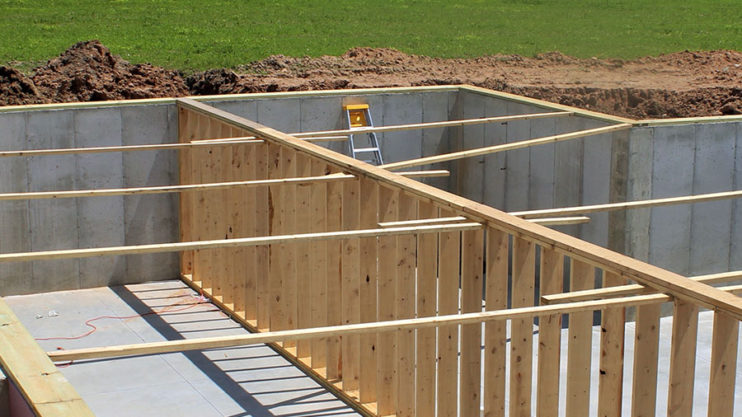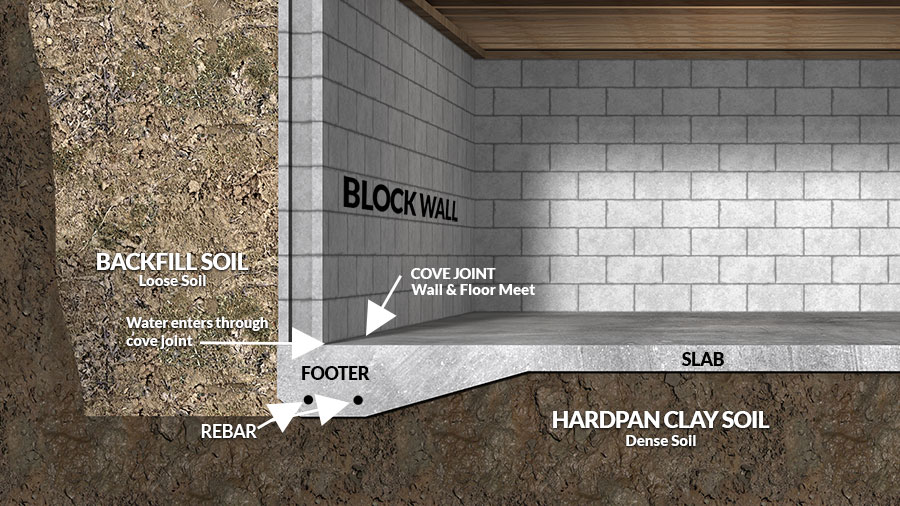What is a Monolithic Slab Foundation?

Share this Post
A monolithic slab foundation is a type of concrete foundation that is poured in one piece, typically 4-6 inches thick, and serves as both the floor and foundation of a building. It is commonly used in areas with shallow soil frost depths and is known for its durability and efficiency.
Table of Contents
Do You Have a Traditional Basement or a Monolithic Slab Foundation?
Basement foundation: This is a t-shaped foundation with multiple parts. A footing is placed below the frost line. Blocks are laid, or concrete is poured to form a wall once the footing has cured. After constructing the walls, a slab floor is poured between them and on top of the footing.
Monolithic Slab: This foundation is created by pouring a single layer of concrete to form a slab and footing. Contractors like the monolithic concept because it keeps the labor cost low, and the construction process is faster than other foundations.
A familiar monolithic slab foundation is 12 to 18 inches thick at the footing and 4 to 6 thick for the slab. Proper site preparation and concrete reinforcement using rebar and wire are required to construct a monolithic foundation.
Proper Site Preparation
- The soil below the slab should not contain organic matter. The soil needs to be compacted (removal of topsoil) and well-drained.
- Code enforcement determines the type and positioning of reinforcements in this foundation. The most commonly used is monolithic slab #4 rebar. Rebar is two metal bars that bend easily and are placed side by side in an overlapping fashion in the trenches and tied with a wire.
- The trench along the slab’s perimeter creates a thickened edge. Building code officials determine the depth and width of the trench. This trench can be 1 ft wide and 1 ft deep in warm climates or 1 ft wide and 2 feet deep in environments that experience frost heave.

Pros of Monolithic Slab Foundation
There are many advantages to a monolithic foundation over a traditional foundation. The pros include the following:
- Construction is quick and easy: Once the perimeter trench has been added and the gravel has been spread out, pouring the concrete floor can begin.
- This foundation dries faster than all other foundations.
- A strong foundation: This foundation is strong, provided anchor bolts and reinforcements are correctly installed.
- Low-maintenance: Monolithic foundation only needs inspections at scheduled intervals to ensure no cracks in the foundation.
- Energy-efficient: Less energy is wasted because there isn’t a space between the home and the ground. Air doesn’t travel under the subfloor.
Cons of Monolithic Slab Foundation
Of course, there are disadvantages when installing a monolithic foundation design. Here the cons of this type of foundation:
- Risk of flooding: Your home is only raised by approx. 6 inches above the ground line with this foundation, so the house is at risk for flooding.
- Cost of repairs are expensive: When there is a crack in the foundation, costly repair methods are required.
- A diminished resale value is possible.
When Should You Choose a Monolithic Slab Foundation?
There are several instances where a slab foundation is an ideal choice:
It’s an ideal option for climates where the ground doesn’t freeze, and the temperature is not very hot, nor is it desert-like. You can use a monolithic slab to increase energy efficiency if you don’t need a basement or crawl space.
What Are Some Issues With a Monolithic Foundation?
Despite the convenience and ease of installing a monolithic foundation, issues could compromise the foundation. The foundation can require expensive repairs, so it could be better to go with a traditional one.
- Foundation cracks are a large area of concern. When the foundation cracks, the foundation can separate at the cold joints (wall meets slab). The narrow openings make it easier for water, moisture, and bugs to enter the home.
- Problems with increasing moisture in the soil or improper construction can compromise the foundation. It may lead to countertops, floors, and walls in the home becoming unlevel.
- Movement in the foundation can lead to doors and windows that stick and cracks in sheetrock walls.
When to Avoid a Monolithic Slab Foundation for Construction
- Contractors should avoid using monolithic slab foundations (monopour) in specific situations.
- Homesites that are sloping can lead to costly expenses because of the amount of concrete needed.
- Homesites with many dirt-filled holes under the home lead to cracking in the concrete.
- Due to code requirements, a construction company cannot build a monolithic slab foundation in a flood zone.
Cost of a Monolithic Foundation
An average foundation’s cost can vary between $4,600 to $20,000, depending on several factors. Some factors that determine the foundation’s price include where you live, the size of your home, the reinforcements used in the concrete, the thickness, and the soil you are building on.
Schedule a free, no-obligation inspection and quote at no cost.